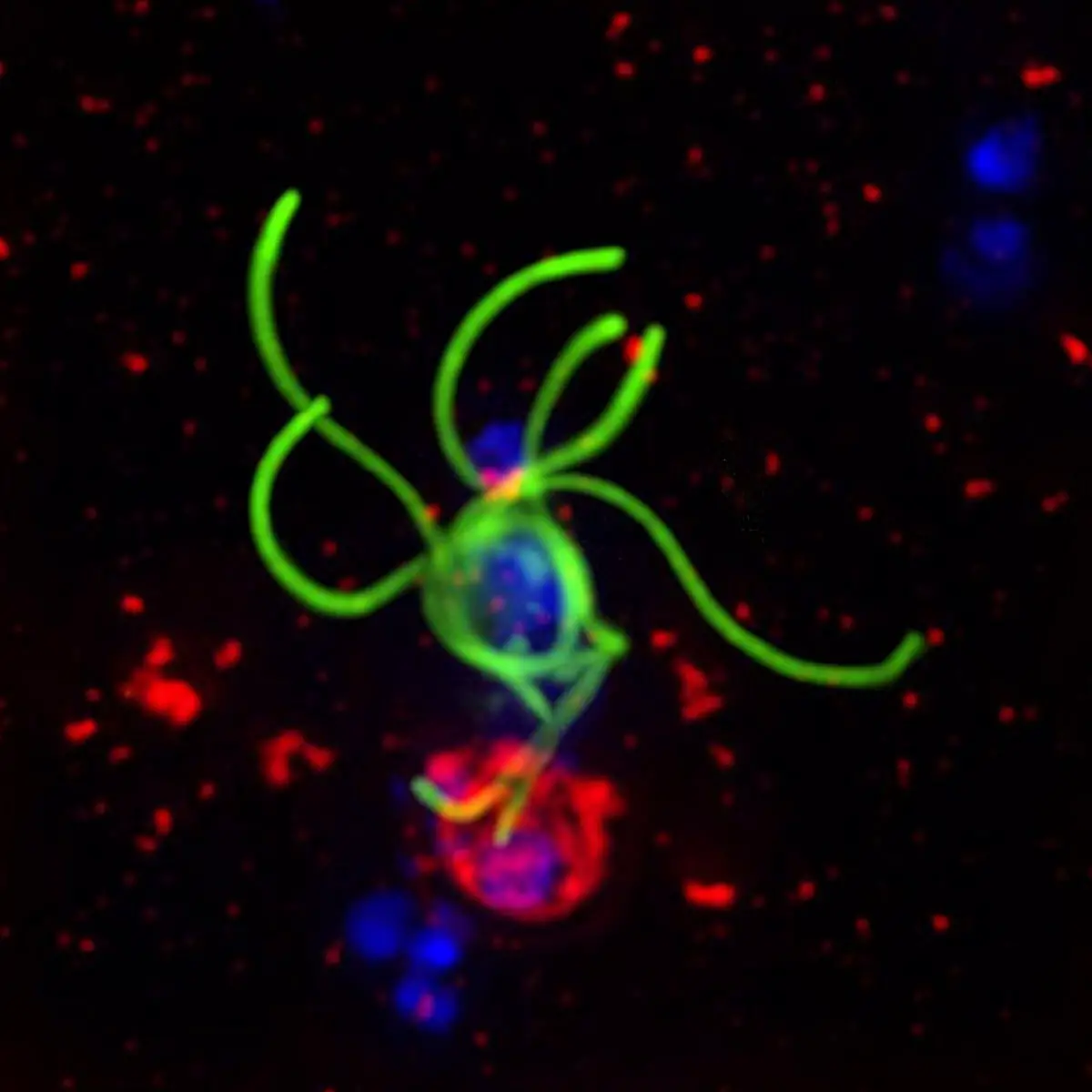

The human-infecting malaria parasite, Plasmodium falciparum (green), is depicted erupting from human red blood cells (red). Eight sexually mature parasites (green) emerge from the human cell (red), with their replicating DNA shown in blue. Credit: This image is courtesy of Dr. Sabrina Yahiya and Professor Jake Baum
Malaria is a devastating illness, with a staggering 247 million reported cases and 619,000 fatalities in 2021. This disease, caused by the parasite Plasmodium falciparum, which is transmitted by mosquitoes, leads to fever and flu-like symptoms. Although there have been advancements in the treatment of malaria with medications to alleviate symptoms and insecticides to eliminate malaria-carrying mosquitoes, both the parasite and mosquitoes are continuously evolving, becoming resistant to these measures.
Consequently, the development of new antimalarial drugs is a pressing issue. A crucial objective is to stop the spread of the parasite from humans to mosquitoes, which is dependent on the sexual phase of its life cycle. The Baum laboratory, in collaboration with researchers at Imperial College London, UK, has previously uncovered a novel class of highly effective antimalarial compounds belonging to a family of sulphonamides.
These compounds kill the parasite only when it is in a specific sexual phase of its life cycle, rapidly stopping it from being able to infect a mosquito and, therefore, preventing any subsequent human infection. In their new Disease Models & Mechanisms article, Baum and colleagues explored exactly how these compounds work, which is an essential step before the compounds can be developed for testing in patients.
The lead author of the work, Dr. Sabrina Yahiya, commented that “targeting parasite transmission from human to mosquito and back again is pivotal if we hope to reach the goal of worldwide malaria elimination. If you only treat one symptomatic patient, you address their symptoms but neglect the issue of malaria spread. By limiting transmission, however, you can radically curtail the spread of malaria across a population”.
The team began by growing human red blood cells infected with the malaria parasite in the lab, then manipulated the parasites to enter their sexual life stage. The scientists then treated these parasites with one of the sulphonamide compounds to find out which parasite proteins were being targeted by the transmission-blocking compounds. To do so, the scientists applied ‘click chemistry’, an approach that won the 2022 Nobel Prize in Chemistry to attach a chemical label to the sulphonamide compounds.
This label would then tag any parasite proteins that came in contact with them. This technique identified a parasitic protein called Pfs16 as forming the strongest bond with drug. Interestingly, Pfs16 is important for sexual conversion of the malaria parasite. The team then performed additional experiments to confirm that the sulphonamides bind Pfs16 and, importantly, block its function.
The scientists then wanted to pin down the exact point in the parasites’ sexual phase that was being targeted by the sulphonamides. After malaria parasites commit to either male or female forms in human blood, they can be transmitted to mosquitoes and once in the mosquito gut develop into a more mature sexual phase. These mature male and female parasites – similar to the human egg and sperm – then fuse to enable sexual reproduction. The newly reproduced parasites undergo further maturation and are then transferred by the mosquito to infect more humans.
The process of sexual maturation, which normally occurs in the mosquito gut, can be activated artificially in the lab and takes roughly 10-25 minutes in total. The authors found that the sulphonamide compounds specifically targeted male parasites and uniquely inhibited their sexual maturation if administered to the parasite within the first 6 minutes of the sexual maturation process, which is the same time that the parasitic protein target, Pfs16, plays an important role in blocking male parasite maturation.
By identifying the compound’s target and window of activity, this work provides a more precise understanding of the parasites’ life cycle stage during which this class of sulphonamides are effective. It also highlights the unique ability of these compounds to rapidly block sexual maturation, and by extension, malaria parasite transmission, by targeting the important parasite protein, Pfs16.
Overall, Baum and colleagues have identified how this new class of antimalarials blocks the parasite from reaching sexual maturity, and therefore, their spread from human to human via a mosquito bite. This is an important step in developing effective new drugs to reduce the massive number of new malaria cases worldwide. Once thoroughly developed and tested, these compounds could be given to patients with malaria alongside existing therapies for treating their symptoms, to prevent the parasite from being spread to more individuals.
Professor Baum also stated that “the unique ability of this class of sulphonamides to potently block sexual maturation of the parasite with almost immediate impact makes the direct delivery of the compounds to the mosquito a very appealing alternative administration strategy.” This exciting alternative strategy could be achieved by coating mosquito nets or sugar baits with the compounds. More research is underway to explore and refine the activity of this class of sulphonamides for use either in humans or directly with mosquitoes, but nevertheless, this study expands the breadth of strategies available to use in the fight against malaria.
Reference: “A novel class of sulphonamides potently block malaria transmission by targeting a Plasmodium vacuole membrane protein” by Sabrina Yahiya, Charlie N. Saunders, Sarah Hassan, Ursula Straschil, Oliver J. Fischer, Ainoa Rueda-Zubiaurre, Silvia Haase, Gema Vizcay-Barrena, Mufuliat Toyin Famodimu, Sarah Jordan, Michael J. Delves, Edward W. Tate, Anna Barnard, Matthew J. Fuchter and Jake Baum, 30 January 2023, Disease Models & Mechanisms.
DOI: 10.1242/dmm.049950
The study was funded by the Engineering and Physical Sciences Research Council, the Bill and Melinda Gates Foundation, the Wellcome Trust, Medicines for Malaria Venture, and the Royal Society.